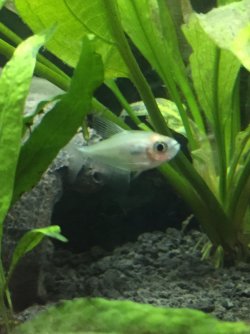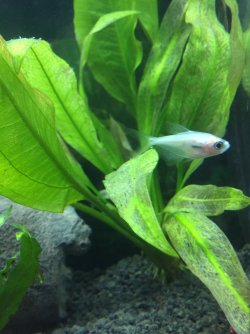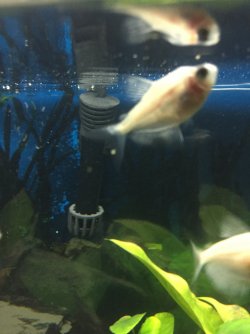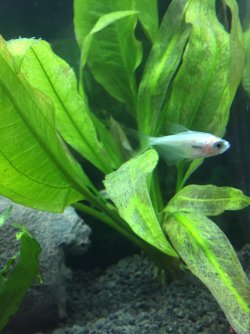Cup o' Joe
New Member
- Joined
- Sep 30, 2017
- Messages
- 13
- Reaction score
- 1
Tank size: 16 gallon
pH: 8.4
ammonia: unknown
nitrite: 0
nitrate: 20 ppm
kH: 300
gH: 75
tank temp: 80F
Fish Symptoms (include full description including lesion, color, location, fish behavior):
Not very energetic, tend to hide in lower half of tank/inside decorative logs. Eating only half-heartedly compared to the healthy tetras. Periodically expelling white/semi-transparent stringy poop. The texture is relatively uniform (no sign of worm eggs, blood, etc.). Suspicious black segment inside sick fishes' organs, possibly in digestive tract.
Volume and Frequency of water changes:
20-25% change weekly/biweekly. Did 2 of those back to back a week ago due to nitrite spike from medicating. Parameters have stabilized since then.
Chemical Additives or Media in your tank:
root tabs and plant nutrient supplement. dilute (9.5%) sulfuric acid to lower pH. general paraguard treatment 2 weeks ago, then prazipro since then every 4-5 days.
Tank inhabitants:
4 white skirt tetras. Also had a 5th tetra lost to the disease 2 weeks ago.
Recent additions to your tank (living or decoration): none. relatively new tank (1.5 months old)
Exposure to chemicals: nothing I haven't listed
Digital photo: see attached.
Additional notes:
First of all before anyone brings it up, I understand 8.4 is on the high side for pH. My local tap water is very alkaline so it's difficult to avoid. I've been treating regularly with pH buffers but I can't make too much of a change at once. Also, I tested the petstore tank parameters and they have the same issue, so it's probably best that my pH isn't too low so new fish don't get pH shock. Additionally, I've successfully kept black skirt tetras in similar conditions (they lived for 4 years before a tragic moving accident shattered the 30 gallon I had) so I don't believe the pH to be the issue here.
Just to provide a bit more context here. I've only had this tank for a month or two. I started it with some planted aquarium substrate and some standard deco, planted with anubias, amazon swords and java ferns on day two. Around day 5 after the parameters had stabilized I bought three tetras as a pilot group. They seemed to do fine for a few days but then the smallest one began exhibiting these symptoms (minus the black spot) and died before I could obtain any treatment. I waited a little while to see if the others got sick, but they seemed extremely healthy so I chalked up the death to acclimation stress. I then bought two more so they could school. They all did fine for a week before one of the two new ones began exhibiting those symptoms (again the smallest!). At that point I realized it was something else. I immediately started using a paraguard general treatment to try to stall for more time. The second new tetra may have caught it during that time.
After a lot of research my best guess is that it's some sort of internal parasite, most likely some sort of worms. I switched to prazipro dewormer after that. It seems to have stalled the disease from worsening (it's been almost 3 weeks since I first noticed it) but there also haven't been any marked improvements in the fish. The sick ones have gone from just hiding in the bottom to taking half-hearted nibbles at food before spitting it out again, but no improvements since then around 4 days ago. The pooping has stopped but I don't know if that's just because they haven't eaten at all. The larger of the two sick ones has been better off overall and has occasionally chased one of the healthy ones around for a little bit. However like the smallest one it also hasn't eaten at all (as far as I can tell) in at least 5 days. I'm worried that even if the disease doesn't progress they'll eventually starve to death.
TL;DR 2/4 fish are sick (maybe worms). Any feedback on whether my diagnosis is correct/ any suggestions for better treatments, or should I keep on doing what I have been doing? Any help is greatly appreciated!!!
pH: 8.4
ammonia: unknown
nitrite: 0
nitrate: 20 ppm
kH: 300
gH: 75
tank temp: 80F
Fish Symptoms (include full description including lesion, color, location, fish behavior):
Not very energetic, tend to hide in lower half of tank/inside decorative logs. Eating only half-heartedly compared to the healthy tetras. Periodically expelling white/semi-transparent stringy poop. The texture is relatively uniform (no sign of worm eggs, blood, etc.). Suspicious black segment inside sick fishes' organs, possibly in digestive tract.
Volume and Frequency of water changes:
20-25% change weekly/biweekly. Did 2 of those back to back a week ago due to nitrite spike from medicating. Parameters have stabilized since then.
Chemical Additives or Media in your tank:
root tabs and plant nutrient supplement. dilute (9.5%) sulfuric acid to lower pH. general paraguard treatment 2 weeks ago, then prazipro since then every 4-5 days.
Tank inhabitants:
4 white skirt tetras. Also had a 5th tetra lost to the disease 2 weeks ago.
Recent additions to your tank (living or decoration): none. relatively new tank (1.5 months old)
Exposure to chemicals: nothing I haven't listed
Digital photo: see attached.
Additional notes:
First of all before anyone brings it up, I understand 8.4 is on the high side for pH. My local tap water is very alkaline so it's difficult to avoid. I've been treating regularly with pH buffers but I can't make too much of a change at once. Also, I tested the petstore tank parameters and they have the same issue, so it's probably best that my pH isn't too low so new fish don't get pH shock. Additionally, I've successfully kept black skirt tetras in similar conditions (they lived for 4 years before a tragic moving accident shattered the 30 gallon I had) so I don't believe the pH to be the issue here.
Just to provide a bit more context here. I've only had this tank for a month or two. I started it with some planted aquarium substrate and some standard deco, planted with anubias, amazon swords and java ferns on day two. Around day 5 after the parameters had stabilized I bought three tetras as a pilot group. They seemed to do fine for a few days but then the smallest one began exhibiting these symptoms (minus the black spot) and died before I could obtain any treatment. I waited a little while to see if the others got sick, but they seemed extremely healthy so I chalked up the death to acclimation stress. I then bought two more so they could school. They all did fine for a week before one of the two new ones began exhibiting those symptoms (again the smallest!). At that point I realized it was something else. I immediately started using a paraguard general treatment to try to stall for more time. The second new tetra may have caught it during that time.
After a lot of research my best guess is that it's some sort of internal parasite, most likely some sort of worms. I switched to prazipro dewormer after that. It seems to have stalled the disease from worsening (it's been almost 3 weeks since I first noticed it) but there also haven't been any marked improvements in the fish. The sick ones have gone from just hiding in the bottom to taking half-hearted nibbles at food before spitting it out again, but no improvements since then around 4 days ago. The pooping has stopped but I don't know if that's just because they haven't eaten at all. The larger of the two sick ones has been better off overall and has occasionally chased one of the healthy ones around for a little bit. However like the smallest one it also hasn't eaten at all (as far as I can tell) in at least 5 days. I'm worried that even if the disease doesn't progress they'll eventually starve to death.
TL;DR 2/4 fish are sick (maybe worms). Any feedback on whether my diagnosis is correct/ any suggestions for better treatments, or should I keep on doing what I have been doing? Any help is greatly appreciated!!!






 I would consider your tank much too small for this species for that reason.
I would consider your tank much too small for this species for that reason.